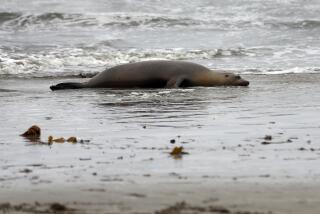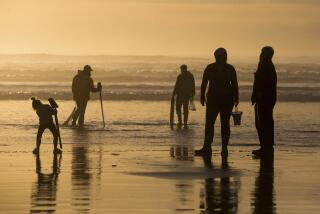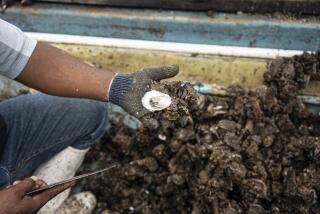Oyster Blight Takes Shine Off Japanâs Pearl Industry
MIURA HARBOR, Japan â Every January, like his father before him, Hiroaki Hamada begins hoisting his barnacled oyster traps out of these aquamarine waters to harvest the treasures within: lustrous, warm-hued pearls that are considered the worldâs very finest.
Except that this month, nearly half of his akoya oysters were dead on arrival at the dock. And many of the survivors were shriveled, yielding dull or discolored pearls.
A mysterious oyster blight in its fifth year is devastating the precious akoyas--and threatening the future of Japanâs century-old pearl cultivating industry.
The strange mollusk malady is characterized by a reddening of the muscle that opens and closes the oyster. Scientists have determined that the inflammation is caused by an infectious disease, said fish pathologist Dr. Toshihiko Matsusato of the National Research Institute of Fisheries Science in Yokohama.
But despite three years of frantic research, they have yet to identify the pathogen. The leading suspects are a virus or one of several types of microorganisms known to afflict mollusks, Matsusato said. Scientists do not know where the epidemic originated, why the disease kills 70% of akoyas but is less deadly to its oyster cousins, or what to do about it.
Research progress has been slow, both because little is known about mollusk pathology and because this disease is so deadly that akoyas used as control groups in early experiments also died, Matsusato said.
Meanwhile, Japanese pearl production has plunged 60%, from 73 tons at its 1993 peak to just 29 tons in 1998, according to government statistics.
It was Japanâs Kokichi Mikimoto who founded the industry in 1893 by figuring out how to trick akoyas into producing a pearl. Japanese pearls became not just an international fashion essential but a gleaming symbol of the precision and quest for quality that have come to define this culture.
The best-quality akoyas--pearls that can command from $10,000 to $150,000 for a single strand in the velvet display cases of jewelers such as Mikimoto and Tiffany & Co.--are growing rarer. Prices for those pearls probably will rise this year, said Shigeru Akamatsu, general manager for sales promotion at Mikimoto. How high the market could rise wonât be clear until this yearâs pearl harvest, which is expected to be slightly better than last yearâs, is brought to auction later this spring.
Before the disease appeared, akoya pearls made up 80% of the Japanese market and 65% of all cultured pearls sold in the United States. But as the supply, size and quality of the beloved akoyas dwindle, Japanese and foreign buyers are stocking up on black pearls from Tahiti, golden orbs from Indonesia and huge creamy whites from Australia. And they are snapping up freshwater pearls from China, which is fast divining the art of mass-producing reasonable quality pearls at prices the Japanese cultivators cannot match.
The result: a string of bankruptcies and reported suicides among Japanâs beleaguered pearl producers, and a tide of red ink for the many businesses that depend on them.
No place has been as hard hit as Ehime prefecture, ground zero of the oyster plague. Its warm, shallow bays on the western shore of Shikoku island were the source of up to 80% of all Japanese pearl oysters until the shellfish began to die en masse in 1995.
Like much of the Japanese economy, the pearl industry is tightly regulated, and producers are allowed to either cultivate pearls or raise baby oysters, but not both.
Twice a year, the oyster breeders sell their young shellfish to pearl cultivators from around Japan. The cultivators seed an oyster with a bead made from the thick shell of a freshwater mussel native to Tennessee. Then they wait a year or two for the oyster to coat the irritant with lustrous nacre before harvesting the pearls.
Unfortunately for Ehime, its baby oysters were sent to pearl farms in harbors all over western Japan before they were identified as the source of the oyster plague. Between 60% and 70% of all akoyas died in 1996 and 1997.
The death rate has since dropped in some parts of the country. But as of the latest survey, in November, the average mortality rate for Ehime akoyas was 39%, according to Tsuneo Morizane, chief of the Ehime Prefecture Fisheries Laboratory in the city of Uwajima. In southern areas, where the waters are warmer, it was as high as 70%, he said.
âThe industry will be ruined in a year or two if this problem continues,â Morizane said.
Understandably, the pearl producers are clamoring for a cure.
âEven when I go for a drink, bar owners ask me, âWhen are you going to find the answer?â â Morizane sighed. âThe bars are all in trouble because the pearl people never go drinking anymore.â
Many in the pearl industry suspect--though without proof--that Ehime oyster cultivators inadvertently imported the virus from China when a similar species was brought over to improve Japanese breeding stocks. The Chinese government does not officially allow export of its oysters, but the policy is not enforced, and oysters have been brought into Japan unofficially, industry sources say.
Whatever the source of the disease, Ehimeâs baby oysters are now anathema to pearl cultivators in other areas. They are trying to keep the contagion at bay by breeding their own oysters from uncontaminated stocks.
Since the epidemic began, 15% of licensed pearl cultivators and 23% of oyster breeders have gone out of business, according to the Ehime Prefecture Fisheries Assn. Pearl producersâ incomes have shrunk to a fifth of what they were at their 1993 peak.
Pearl cultivator Zentaro Yamamoto, 53, recalls the boom years when pearls seemed to be popping from a sea that had once yielded nothing more valuable than sardines. Yamamoto walked around with a roll of yen bills worth $10,000 in his pocket, and his son bought 14 cars.
Other families who had eked out a living growing mikan tangerines on steep hillsides before turning to oysters had their family crests encrusted in pearls, said a local innkeeper. The wives of pearl entrepreneurs vied to buy $30,000 obi sashes from kimono dealers who drove for hours down the winding coastal road to flog their wares to a newly rich clientele.
Now Yamamoto has laid off his five employees and tends his oysters with his wife, son and daughter-in-law.
âNo matter how hard I work, Iâm in the red,â he said. He knows of 12 pearl cultivators who have committed suicide since the disease surfaced.
More are expected to go under this year, done in by Japanâs economic stagnation, a feeble demand for luxury items because of the Asian economic downturn and a domestic credit crunch as debt-ridden banks improve their balance sheet by cutting off bad borrowers.
Many pearl producers, awash in red ink after four years of heavy losses, will be unable to borrow capital to invest in a new oyster crop, cultivators said.
On Jan. 5, Japanâs fifth-largest pearl business, Yamakatsu Pearl Co., collapsed under a mountain of bad debt. News reports blamed the companyâs woes on huge losses from oyster-farming operations and steep competition from Australian and South Sea pearls, which has kept prices down.
âThe truth is, prices have been stable although production has fallen so much,â said Kazushiro Yamauchi, who markets pearls for the Miura Fisheries Assn. âThere isnât much demand.â
For Japanâs pearl industry to prevail, it must produce a high-quality product. And so the pearl cultivators have begun experimenting with new breeds of oysters, new cultivating techniques for the fragile akoyas and new breeding grounds.
Morizaneâs laboratory and fisheries associations are attempting to raise stronger strains of oysters from offspring of mollusks that have not been killed by the blight. They also have imported Chinese oysters--which, even if they might carry the infection, are less likely to die of it--to breed them in Japanese waters and produced a Japanese-Chinese hybrid that will be seeded with pearl nuclei for the first time this spring.
âWe are not using Japanese natural oysters this year. They die,â said Yutaka Miyashita, head of the fisheries association in the Shimonada district. âWeâve lost too much money on them.â
Though the Chinese oysters do get the reddening disease, which also has been observed in China, they are hardier and less likely to die of it, Morizane said. The average death rate for Chinese oysters is just 14%, compared with the 39% for the akoyas.
âWe canât say why they are more resistant,â Morizane said.
Oysters are delicate creatures that must be bullied into producing pearls. Stress is what prompts them to secrete their shiny nacre, and so cultivators torment them by washing their shells, moving them to different harbors, and raising and lowering their cages in the ocean to subject them to changing water temperatures, explained Mikimotoâs Akamatsu.
Annoy an oyster too much, however, and it dies--especially if it is weakened by disease, pollution or water that is too warm or cold.
Japan has a century of experience with akoyas, but it could take years before farmers learn how to get fine pearls out of finicky foreign oysters--if that can be done at all.
It has taken Tasaki Shinju, Japanâs No. 2 pearl company, two decades to commercialize cultivation of luscious gold pearls from Indonesian oysters at a pearl farm in southern Japan.
The native Chinese oysters have nacre with a yellowish cast that makes their pearls less valuable. Ehime farmers say that after spending time in colder Japanese waters, the nacre tends to become pinker, but it is too soon to know for sure. And because the oysters are small, their pearls are undersized too.
Other cultivators are experimenting with oysters from Cambodia, while several pearl-farming families from Ehime have moved their operations to Thailand, Vietnam and China. Akamatsu sniffed at the idea of Chinese or Cambodian oysters displacing the prized akoyas.
Akamatsu said the death rate this year at Mikimotoâs own pearl farms is less than 20%, due to careful quarantine of uncontaminated breeding stocks. And though the situation in Ehime is dreadful, he said, the akoyasâ survival rate has improved in areas of Kyushu island and Mie prefecture that are breeding their own oysters from disease-free stocks.
Many in the pearl industry fear that a virus isnât the only cause of the akoyasâ woes. Even before this disease appeared, some producers believed that the oyster had been weakened by overbreeding, overcrowding and pollution.
Others pointed the finger at the fish farmers who raise fugu, a poisonous but tasty Japanese blowfish, for contaminating the seas with chemicals used to fight fugu parasites. But that toxic chemical, Formalin, has been banned, and the akoyas are none the healthier.
Global warming is seen as the scariest threat of all. For the past two years, the waters off Ehime have been 1.5 degrees warmer than the average for the 15 preceding years, according to prefectural data. Higher temperatures make shellfish more susceptible to disease. Tasaki Shinju founder Shunsaku Tasaki predicted that the akoya farmers will have to wait the epidemic out, trying to improve environmental conditions and leaving the oysters to overcome the disease naturally.
âThe gods are now adjusting things,â he said.
*
Chiaki Kitada in The Timesâ Tokyo Bureau contributed to this report.
More to Read
Inside the business of entertainment
The Wide Shot brings you news, analysis and insights on everything from streaming wars to production â and what it all means for the future.
You may occasionally receive promotional content from the Los Angeles Times.










